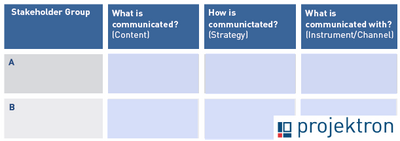10/12/2022 - Articles
Successful project communication: Communication management in projects
One of the main reasons for project failure is poor project communication - according to a study by PMI, professional project communication management is thus just as important for project success as accurate cost estimation, a clear definition of project goals and a thorough risk analysis. What exactly is project communication and what should be considered? Projektron gives 3 practical tips.

What is project communication?
The term project communication refers to communication forms and activities related to a project. It includes unidirectional transmission of information and dialog between different project participants and stakeholders. Participating parties in project communication are, for example:
|
|
|
Depending on the purpose of the information, different communication channels, tools and techniques must be selected for this purpose. The content and frequency of the information to be communicated varies depending on the role of the communication participants:
The client should be regularly informed about the progress of the project (e.g. via the status report)
Project managers and the project team regularly exchange information about progress and upcoming tasks in project meetings.
People affected by the course of the project want information about consequences (e.g., threatened loss of job, change in range of tasks)
Stakeholders want to know what project outcomes they can expect.
Project communication is thus broader and more holistic than project marketing, which merely aims to influence the project environment in terms of project success by means of promotional presentation.
Why is project communication important?
The following is true not only in project management: There is no such thing as non-communication. Even if we do not actively communicate information, we are sending a message to people who interact with us - as a rule, this message is decoded as less than positive because it does not meet expectations. Naturally, those affected by the project (stakeholders) demand information about the project. Team members can better classify their tasks, affected persons (e.g. residents of a construction project), service providers and customers know that the project is on schedule (or not) and can adjust to it.

"You cannot not communicate."
– 1st axiom of the communication theory by Paul Watzlawick
To ensure that the communication that inevitably takes place is in line with the success of the project and does not jeopardize the achievement of the project ojectives, it must therefore proceed in a planned and strategic manner. This results in the need for communication planning.
Communication is a critical success factor in project management. It serves
securing the acceptance and motivation of stakeholders, i.e. all those directly and indirectly involved,
the reduction of fears and anxieties and the resulting conflicts,
the creation of transparency and the ongoing maintenance of trust,
marketing the project to management and staff.
What are the tasks and goals of project communication?
Project communication therefore includes not only the exchange of information within the project team or agreements between management, client, project manager and project team, but also regular dialog with relevant stakeholders.
I-A-C: 3 tasks of project communication
1. Information
Stakeholders and those affected are to be informed about the occasion, background, objectives, current work results, decisions, developments, deviations from the plan and results of the project
2. Acceptance
Reduction of fears and resistance, increase of acceptance and motivation
3. Coordination
All project participants should focus their joint actions on the success of the project. For this purpose, requirements, opinions, goals, wishes and interests must be asked for, discussed and harmonized with each other by means of project communication.
11 Goals of project communication
The exact goal of communication must be individually aligned with the project objectives in each case and also set in relation to the corporate goals. However, the following eleven objectives of project communication can be stated as general guidelines:
- Definition and provision of the communication infrastructure and channels
- Definition and monitoring of communication standards and rules
- Development and implementation of communication concepts for different stakeholder groups
- Alignment of all activities with the project objectives
- Avoidance of redundancies
- Clarification of task descriptions and responsibilities
- Delineation of responsibilities
- Optimization of project execution
- Continuous status review (target/actual comparison)
- Identifying stakeholders and determining communication needs
- Involving stakeholders and creating an opportunity for direct participation
How do you develop communication strategies in terms of project communication?
While communication with project stakeholders can largely take place within the shared software, you need to develop suitable strategies for project communication with external stakeholders. To do this, take a systematic approach and create a communication plan or communication matrix. A communication plan helps you to define the content, type, frequency, scope, channel and level of detail of your communication for specific target groups.
Project communication is target group specific
Communication management in the project requires sound planning: A communication matrix helps you to recognize which participant is informed in which project situations with which measure. Therefore, create a matrix to plan the communication in the project already in the course of the project preparation and not to forget any stakeholder even in tight project situations. Simply download our communication matrix template here and consciously consider a communication strategy for your next project.
From the field: 3 tips for your project communication

Project communication tip 1: Plan early!
Once you have identified and analyzed all stakeholders, you should select suitable communication strategies directly afterwards. In fact, different communication strategies can also be recommended within a predefined stakeholder group. In this case, do not hesitate to refine your previous analysis and split the stakeholder group again. Also re-evaluate the communication strategy per stakeholder group regularly during the course of the project and adjust your chosen communication techniques, channels or even goals in the communication plan accordingly.

Project communication tip 2: Think about the target group!
You will not reach every stakeholder group via the same communication channels. This is precisely why you should empathize with your stakeholder groups and think carefully about which communication channel is most likely to enable you to reach which target group with the message they need. Possible channels range from emails and phone calls to speaking evenings, office hours, workshops and presentation days, surveys, social media campaigns, video streaming and articles in newspapers and magazines.
For each stakeholder group, not only choose the appropriate communication channels and content, but also pay attention to how you need to convey your content so that it can be understood and positively received by your target audience. Technical terms or excessive marketing jargon will not be received positively by every recipient. Always remember to implement a dialogue option as well, and consider ways to handle incoming feedback in advance.

Project communication tip 3: Communication needs resources!
Project communication doesn't just happen on the side or come naturally. Since communication plays a significant role in the success of a project, you should include communication management in your project planning as a separate task with corresponding budget, time and personnel requirements. Particularly in the case of longer projects, accompanying project communication is necessary throughout the entire duration of the project in order to maintain transparency and motivation.
Biggest pitfall in project communication: avoid the most common mistake!
The mistake: decentralization of information
Do you use an external and separate tool for project communication, for example a chat program or a messenger service as well as an e-mail program that is not connected to your project planning tool or project management software via a corresponding interface? Here lurks a common source of error, because in this way you will
- you inevitably store relevant information in a decentralized manner,
- information is not accessible to everyone involved
- important documents are available at different locations in different processing statuses and outdated versions.
While all participants are usually well informed about milestones and results during the course of the project, important information sometimes falls by the wayside during implementation. Progress, instructions and changes are often shared only with colleagues whose work is directly affected.
Solution: Centralization and bundling of information directly on the project
The exchange of information among all project participants should take place directly in the project, at tasks, deadlines and relevant documents. Therefore, use project management software that links all work areas and enables project communication on all these levels.
13 useful tools for project communication in Projektron BCS
To ensure that project planning, project preparation and project communication run together right from the start of the project, the project management software plays a central role: It is not only a tool for planning the project and for project control, but also the tool that should map all project communication with project participants. Projektron BCS offers tools and functions that allow you to plan, centrally collect, store and easily retrieve all your project communication with both internal and external stakeholders.
Some of these functions are as follows:
Progress log |
| Whether important agreements with customers or the contents of a project meeting: In the progress log, the project manager and project team centrally compile all information that is important for your project communication and the success of your project - in chronological order. |
Meeting and agenda planning |
| Structured agenda planning based on collaboratively collected topics within the project team is crucial for a fruitful meeting outcome, be it a team meeting, a weekly, a daily, a status or strategy meeting. With the Meeting Agenda in BCS, you can record meeting results directly on the agenda item during the meeting, generate meeting minutes at the end of the meeting with one click, and send them to participants and external parties so that everyone is aware of the meeting results. |
Contact history with email and call log and call memos |
| The CRM module in BCS stores incoming as well as outgoing calls and e-mails thanks to appropriate interfaces. If you receive a call, you can store a conversation memo directly at the relevant contact during the call and link the process to the project. |
Project calendar |
| In the calendar, you can quickly and flexibly schedule meetings that all invited participants can view in their personal calendar view, along with project events such as milestones. Each appointment is archived with information about participating persons and any other information related to the project. |
Ticket system for task distribution |
| BCS provides you with project tickets in which you can record spontaneous activities, requests, changes or open items and provide them with the appropriate plan values. The entire communication of the ticket agents and representatives as well as the recording of working hours on tickets goes into the superordinate project. |
Notification function |
| If deadlines are postponed or if there are changes to tasks to be reported, those involved in the project are informed immediately via a notification in BCS and optionally via e-mail. |
Resubmissions |
| With Projektron BCS resubmissions, you quickly create virtual reminders for upcoming activities or tasks for yourself. Delegating tasks to others is also possible via resubmissions: With a click of the mouse, you send an email notification to your colleague so that they are immediately informed about the new resubmission. |
Short message function (chat) |
| In Projektron BCS, you can send simple messages to other users in the form of user messages. In doing so, the message can either be sent to one person or to several people and a context reference can be specified if required, for example, a ticket. |
Status notes of the project manager |
| Project managers can store status notes on the current project status and progress. These messages are optionally displayed to project participants alongside important KPIs such as the total cost overview in the project overview. Important project decisions can thus be communicated quickly and centrally to all those involved. |
Project schedule |
| The view of the project plan as a Gantt chart provides an overall view of the exact project schedule in its temporal course. Tasks are shown here according to their defined sequence and in dependence on other tasks. This allows the team to see in real time whether bottlenecks will arise if tasks or milestones are delayed, enabling them to react in time and adjust the plan. Optionally, the diagram also shows the resource utilization and preview for each individual project participant. The progress of the project is also transparently visible in the schedule. |
Document storage with versioning |
| Upload project-relevant documents directly to tasks or deadlines. Documents are stored in a uniform filing structure so that they can be found again. Authorized employees always have access to relevant information from anywhere. Team collaboration is facilitated because all members have access to the latest document version and changes are traceable. There are no more duplicates or outdated versions of documents. Search and filter functions facilitate knowledge transfer and research. |
External project communication |
| For planning your external project communication, the full functionalities of tasks, tickets, workflows with checklists and deadlines are available in BCS. This allows you to plan project communication as an integral part of the entire project right from the start. Via guest licenses, which can be flexibly defined by means of detailed rights assignment, you can include external stakeholders and offer them direct insight into the project progress or even grant them co-determination rights regarding certain views and aspects. |
Project communication international |
| For teams working internationally, BCS translates automatically. Since the project interface is available in ten different languages by default, everyone involved receives the centrally stored information in their own language. |
Test Projektron BCS free of charge!
Conclusion: Project communication is a critical success factor
Comprehensive, smooth and transparent project communication is a decisive factor for your project success. It is not only an essential part of teamwork during project implementation, but also affects external communication with stakeholders from project initiation through project planning and implementation to project completion. A basic prerequisite for successful project communication is therefore centralized and software-supported communication management.
Well thought-out and planned project communication from the outset is a key factor in preventing project failure. It is therefore essential to take appropriate account of the importance of project communication for the success of your projects: Include project communication management functions in your requirements catalog when selecting project management software.

About the author
Like almost all Projektron GmbH teams, the event organization team uses Projektron BCS not only to plan and manage their projects, but also as a tool to map all project communication with all project stakeholders at the same time. Our event organizers around team and project manager Claudia Kedor rely on the software to plan all project communication to internal as well as external stakeholders, to collect interaction data and relevant documents in a centralized way, to store them and to make them easily retrievable.












